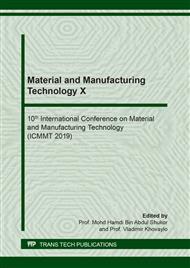p.3
p.8
p.13
p.18
p.23
p.29
p.35
p.40
Sustainable Turning of Biocompatible Materials Using Eco Nano-Mist Technique
Abstract:
In today’s industrial scenario, the requisite for elevated efficiency, better economic viability and higher quality asks for immense improvements in the cutting process stability. Such machining at higher cutting speeds and cutting depths causes an immense amount of heat generation at the work tool interface. The industry makes utilization of cooling techniques to contravene these ill-effects. These techniques make utilization of chemical coolants which are non-biodegradable in nature and consumed in immense quantities. In this study the role of minimum quantity lubrication (MQL) or green machining was experimentally evaluated when utilizing nanoparticle enriched coolants. The effect on the wear and roughness values while turning commercially pure Titanium (Grade 3) was analyzed. Experimentation was performed in two phases. In the first phase, the comparison in dry, flood and MQL process was made. The experimental design was composed factorially and 16 experiments were performed. Analysis was carried out utilizing ANOVA and the results were compared. In the second phase, a graphical cognation was established between the coolant application rate with both surface roughness and flank wear values. It was concluded that the nanoparticle enriched coolant i.e. the “eco nanomist”technique was more efficacious when machining the biocompatible Titanium grade 3.
Info:
Periodical:
Pages:
18-22
Citation:
Online since:
March 2020
Authors:
Keywords:
Price:
Сopyright:
© 2020 Trans Tech Publications Ltd. All Rights Reserved
Share:
Citation:


